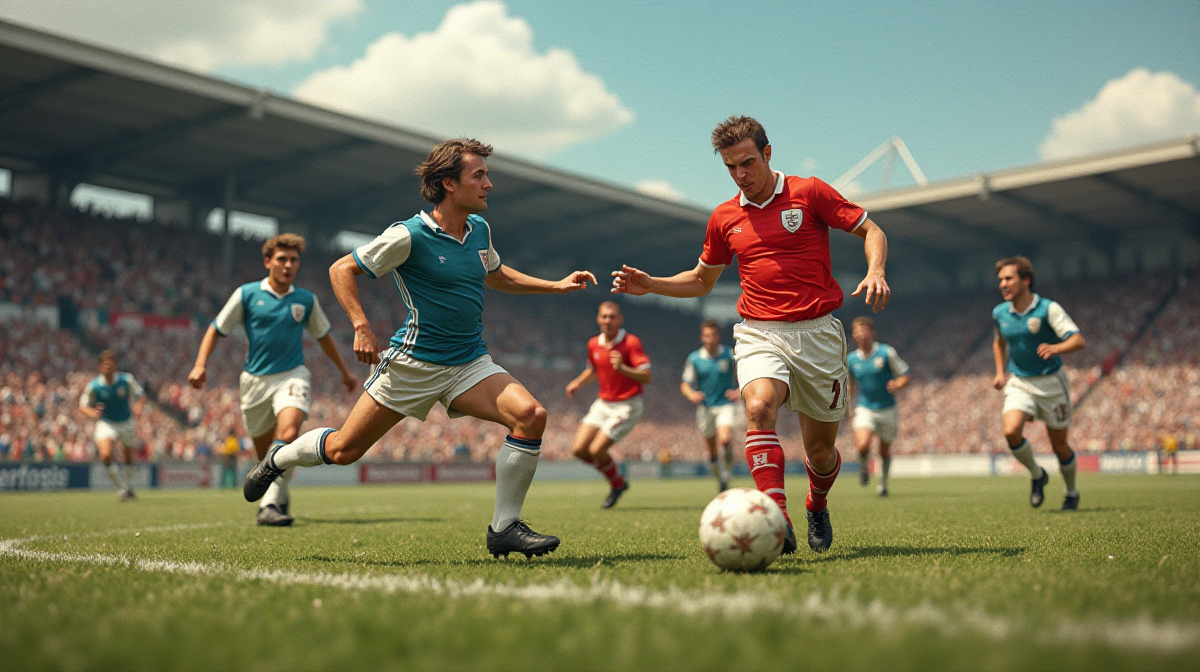1960Tips: Golden Era Football Insights
Introduction: The Golden Age of Football
Defining the “Golden Era” – What Made the 60s Special?
The 1960s represent a watershed moment in football history, often referred to as its “Golden Era.” This wasn't just about exceptional players; it was a confluence of factors. The game was evolving tactically, becoming more dynamic and globally appealing. Post-war reconstruction had fostered a renewed sense of national pride, often expressed through footballing success. Furthermore, the nascent stages of television coverage began to bring the beautiful game into homes, expanding its reach and creating lasting icons. Those seeking correct score predictions today often look back at this era for inspiration, analyzing the foundational tactics that shaped the modern game.
Key Teams & Players to Know
The decade boasted a constellation of legendary teams and players. Benfica, led by the prolific Eusébio, dominated European competition. Real Madrid, with the aging but still impactful Alfredo Di Stéfano, continued their continental reign. Inter Milan, under Helenio Herrera, perfected the art of catenaccio. Manchester United, rebuilt under Matt Busby, showcased attacking football. And, of course, Santos, featuring the incomparable Pelé, captivated the world with Jogo Bonito. Understanding these teams and their stars is crucial for anyone wanting to delve into the nuances of 1960s football. Considering strategies for how to win aviator game requires a similar understanding of patterns and probabilities, much like studying the tactical tendencies of these teams.
The Cultural Context: Football's Place in the 1960s
Football in the 1960s was deeply intertwined with the social and cultural landscape. It provided a sense of community and national identity in a period of significant change. The decade witnessed social upheaval, youth rebellion, and the rise of pop culture, all of which subtly influenced the game’s atmosphere and appeal. Football became a potent symbol of national pride, particularly with the 1966 World Cup held in England. Resources like tips180 can offer insights into the historical context of these matches.
Tactical Innovations & Gameplay of the 1960s
The Shift from WM Formation to 4-4-2: Origins & Impact
The 1960s saw a significant tactical shift away from the traditional WM formation towards the more balanced 4-4-2. The WM, while effective, often left teams vulnerable in midfield. The 4-4-2 provided greater defensive solidity and allowed for more fluid attacking transitions. This change wasn't immediate, but it laid the groundwork for modern formations.
The Rise of Pressing & Counter-Attacking Football
While not as sophisticated as today’s “gegenpressing,” the seeds of pressing and counter-attacking football were sown in the 60s. Teams began to recognize the importance of winning the ball back quickly in the opponent's half and exploiting spaces left behind. Inter Milan, particularly, became renowned for their quick transitions from defense to attack.
The Role of Wing Play: Inside Forwards & Winger Techniques
Wing play remained a crucial component of attacking football. Inside forwards, operating between the winger and the center forward, were key playmakers. Wingers focused on beating their full-back and delivering crosses into the box. Dribbling skills and pace were highly valued attributes.
Defensive Strategies: Marking, Offside Rule, and Sweeper Systems
Defensive strategies were evolving. Man-marking was still prevalent, but zonal marking began to emerge. The offside rule, though existing, was often inconsistently applied. The early stages of the sweeper system, a more proactive defensive approach, started to appear, providing an extra layer of protection behind the defense.
Set Pieces: Developing Strategies & Importance
Set pieces were becoming increasingly important tactical weapons. Teams began to develop specific routines for free kicks and corners, recognizing the potential to create scoring opportunities from these situations.
Iconic Teams of the 1960s & Their Styles
Benfica : Possession & Attacking Flair
Benfica, under the guidance of Béla Guttmann, were the kings of Europe in the early 60s. Their style was characterized by elegant possession football, quick passing, and the devastating finishing of Eusébio. They were a joy to watch, embodying attacking flair.
Real Madrid : European Dominance & Individual Brilliance
Real Madrid continued their dominance of the European Cup, albeit with an aging but still potent Ferenc Puskás. Their approach relied on individual brilliance and a direct, attacking style.
Inter Milan : Catenaccio & Tactical Rigidity
Inter Milan, under Helenio Herrera, revolutionized Italian football with their catenaccio system. This ultra-defensive approach prioritized shutting out the opposition and exploiting counter-attacking opportunities. It was pragmatic and highly effective.
Manchester United : Attacking Football & Youth Development
After the tragedy of the Munich air disaster, Manchester United, rebuilt under Matt Busby, emerged as a force once again. They continued to play attacking football, emphasizing youth development and a dynamic, flowing style.
Santos : Jogo Bonito & Brazilian Samba Football
Santos, with Pelé at his peak, showcased the beauty of Jogo Bonito – the beautiful game. Their style was characterized by flair, improvisation, and a joyful approach to football.
AC Milan – Nereo Rocco’s Tactical Prowess & European Success
AC Milan, under Nereo Rocco, blended Italian tactical discipline with attacking talent, achieving significant European success. Rocco was a master tactician who adapted his approach to suit the opposition.
Star Players & Their Impact on the Game
Pelé: The King & His World Cup Triumphs
Pelé is widely regarded as the greatest footballer of all time. His skill, athleticism, and goal-scoring prowess were unparalleled. He led Brazil to World Cup victories in 1962 and 1970, becoming a global icon. Studying his game reveals a mastery of technique and an innate understanding of space.
Eusébio: The Black Panther & Benfica's Golden Years
Eusébio, the “Black Panther,” was a prolific goalscorer and a dynamic attacker. He spearheaded Benfica’s European success and captivated fans with his pace, power, and clinical finishing.
Franz Beckenbauer: Pioneering the Libero Role
Franz Beckenbauer revolutionized the role of the libero – the sweeper. He possessed exceptional passing ability, tactical intelligence, and leadership qualities, transforming the defensive position into a creative force.
Alfredo Di Stéfano: A Multifaceted Genius
Alfredo Di Stéfano was a complete footballer, capable of playing in any position. He led Real Madrid to five consecutive European Cups and left an enduring legacy on the game.
Bobby Charlton: England's World Cup Hero & Leadership
Bobby Charlton was a graceful and powerful midfielder, renowned for his long-range shooting and leadership qualities. He was a key figure in England’s 1966 World Cup triumph.
Lev Yashin: The Black Spider – Revolutionizing Goalkeeping
Lev Yashin, the “Black Spider,” revolutionized goalkeeping with his athleticism, command of his area, and innovative techniques. He is considered by many to be the greatest goalkeeper of all time.

The World Cup in the 1960s: Key Moments & Changes
1962 Chile World Cup: Brazil's Rise with Pelé
The 1962 World Cup in Chile saw Brazil emerge as a dominant force, even after Pelé was injured early in the tournament. Garrincha stepped up to lead the team to victory, showcasing his incredible dribbling skills.
1966 England World Cup: Football Comes Home & Controversies
The 1966 World Cup, held in England, was a landmark event. England won their first and only World Cup title, but the final was marred by controversy over Geoff Hurst’s goal. Understanding these events can provide insight into how to approach games with strategy, much like understanding the probabilities involved in how to play aviator game and win.
Evolution of World Cup Tactics & Player Styles across the Decade
The World Cup in the 1960s showcased an evolution of tactics and player styles. Teams began to experiment with different formations and approaches, reflecting the broader tactical changes occurring in the game.
The Growing Global Reach of the World Cup
The World Cup's global reach continued to expand in the 1960s, with increasing television coverage and a growing international fanbase. It became a truly global spectacle.
Training Methods & Player Conditioning in the 1960s
Limited Resources - The State of Sports Science & Training
Sports science and training methods were in their infancy in the 1960s. Resources were limited, and training often relied on traditional methods and the coach's intuition.
Emphasis on Physical Conditioning: Running, Stamina, & Basic Strength Training
Training focused heavily on physical conditioning, with an emphasis on running, stamina, and basic strength training. Players were expected to be physically robust and capable of covering large distances.
Tactical Drills & Team Cohesion Building
Tactical drills were used to develop team cohesion and familiarize players with specific formations and strategies. However, these drills were often less sophisticated than those used today.
The Role of Coaches & Their Influence on Player Development
Coaches played a crucial role in player development, providing guidance, motivation, and tactical instruction. Their influence was often significant, shaping the style and approach of their teams.
The Evolution of Stadiums & Fan Culture
Stadium Infrastructure: From Standing Terraces to Early Seating Arrangements
Stadium infrastructure was evolving in the 1960s. Many stadiums still featured large standing terraces, but there was a gradual shift towards more seated accommodation.
Growing Popularity & Fanbase: The Rise of Football Hooliganism
Football's popularity continued to grow, attracting a larger and more passionate fanbase. However, the decade also witnessed the early signs of football hooliganism, a disturbing trend that would escalate in later years.
Matchday Experience: Tickets, Atmosphere, & Media Coverage
The matchday experience was becoming more sophisticated, with improved ticket systems and increased media coverage. The atmosphere in stadiums was often electric, fueled by passionate supporters.
Early Forms of Football Journalism & Broadcasting
Football journalism and broadcasting were in their early stages of development. Coverage was limited, but it was beginning to play a more significant role in shaping public opinion and promoting the game.

The Legacy of 1960s Football & Its Influence Today
Tactical Foundations: How 60s Innovations Resonate in Modern Football
The tactical innovations of the 1960s laid the foundations for modern football. The shift to the 4-4-2 formation, the emphasis on pressing, and the development of set-piece strategies all continue to influence the game today.
The Enduring Appeal of Iconic Players from the Era
The iconic players of the 1960s – Pelé, Eusébio, Beckenbauer, and others – remain enduring figures in football history. Their skill, charisma, and achievements continue to inspire fans and players alike.
The Impact of the 1960s on the Commercialization of Football
The 1960s marked the beginning of the commercialization of football, with increased television coverage and sponsorship deals. This trend would accelerate in subsequent decades.
Comparing & Contrasting Football in the 1960s with the Modern Game
Comparing and contrasting football in the 1960s with the modern game reveals significant changes. The modern game is faster, more physically demanding, and more tactically sophisticated. However, the fundamental principles of skill, teamwork, and passion remain the same. Resources like 1960tips provide a valuable perspective for understanding these changes and appreciating the evolution of the beautiful game.

